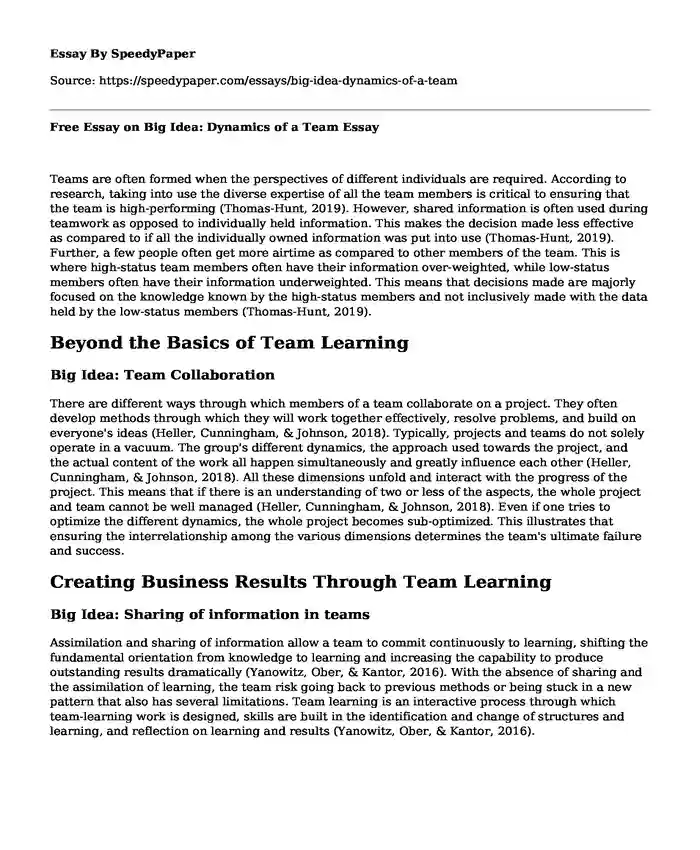
| Type of paper: | Essay |
| Categories: | Goal Human resources Interpersonal communication |
| Pages: | 3 |
| Wordcount: | 713 words |
Teams are often formed when the perspectives of different individuals are required. According to research, taking into use the diverse expertise of all the team members is critical to ensuring that the team is high-performing (Thomas-Hunt, 2019). However, shared information is often used during teamwork as opposed to individually held information. This makes the decision made less effective as compared to if all the individually owned information was put into use (Thomas-Hunt, 2019). Further, a few people often get more airtime as compared to other members of the team. This is where high-status team members often have their information over-weighted, while low-status members often have their information underweighted. This means that decisions made are majorly focused on the knowledge known by the high-status members and not inclusively made with the data held by the low-status members (Thomas-Hunt, 2019).
Beyond the Basics of Team Learning
Big Idea: Team Collaboration
There are different ways through which members of a team collaborate on a project. They often develop methods through which they will work together effectively, resolve problems, and build on everyone's ideas (Heller, Cunningham, & Johnson, 2018). Typically, projects and teams do not solely operate in a vacuum. The group's different dynamics, the approach used towards the project, and the actual content of the work all happen simultaneously and greatly influence each other (Heller, Cunningham, & Johnson, 2018). All these dimensions unfold and interact with the progress of the project. This means that if there is an understanding of two or less of the aspects, the whole project and team cannot be well managed (Heller, Cunningham, & Johnson, 2018). Even if one tries to optimize the different dynamics, the whole project becomes sub-optimized. This illustrates that ensuring the interrelationship among the various dimensions determines the team's ultimate failure and success.
Creating Business Results Through Team Learning
Big Idea: Sharing of information in teams
Assimilation and sharing of information allow a team to commit continuously to learning, shifting the fundamental orientation from knowledge to learning and increasing the capability to produce outstanding results dramatically (Yanowitz, Ober, & Kantor, 2016). With the absence of sharing and the assimilation of learning, the team risk going back to previous methods or being stuck in a new pattern that also has several limitations. Team learning is an interactive process through which team-learning work is designed, skills are built in the identification and change of structures and learning, and reflection on learning and results (Yanowitz, Ober, & Kantor, 2016).
Optimizing the Significance of Action Learning
Big Idea: Elements of Learning
There are different critical elements of learning, and they often have multiple purposes. This allows a consistent capacity to solve efficiently or effectively different challenges and problems with different sustaining and breakthrough challenges (Marquardt et al., 2018). It also allows the development of qualities and skills by the managers of the 21st century. It further enables the development of teams to ensure that they continuously adapt and improve their capabilities (Marquardt et al., 2018). Moreover, it provides that there are potent competencies for learning and coaching. It also ensures that organizations are transformed for learning. Action learning has been developed well, and this is because it integrates seamlessly and thoroughly where the best practices and principles of different theories come from various fields (Marquardt et al., 2018). Action learning is also significant since it puts together and captures the best way group members think, and it enriches the abilities of these groups (Marquardt et al., 2018). It is based on different components, including urgent and vital issues, a diverse team of different people, a reflective inquiry procedure, a present coach for action learning, commitment to education, and implement action, and a diverse group. There are different norms, and these include questions before statements and learning as the action progresses.
References
Heller, D., Cunningham, L., & Johnson, L. (2018, February 6). Beyond the Basics of Team Learning: Integrating Process and Project. Retrieved from https://thesystemsthinker.com/beyond-the-basics-of-team-learning-integrating-process-and-project/
Marquardt, M., Banks, S., Cauwelier, P., & Seng Ng, C. (2018). Optimizing the Power of Action Learning: Real-Time Strategies for Developing Leaders, Building Teams, and Transforming Organizations (3rd ed.). Boston: Nicholas Brealey Publishing.
Thomas-Hunt, M. (2019). Team Dynamics. Retrieved from https://womensleadership.stanford.edu/teamYanowitz, J., Ober, S., & Kantor, D. (2016, September 12). Creating Business Results Through Team Learning. Retrieved from https://thesystemsthinker.com/creating-business-results-through-team-learning/
Cite this page
Free Essay on Big Idea: Dynamics of a Team. (2023, Aug 02). Retrieved from https://speedypaper.net/essays/big-idea-dynamics-of-a-team
Request Removal
If you are the original author of this essay and no longer wish to have it published on the SpeedyPaper website, please click below to request its removal:
Popular categories




